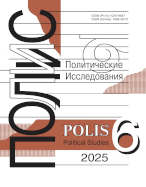Polis. Political Studies
What manuscripts we seek
“Polis. Political Studies” journal publishes manuscripts that make outstanding contributions to scholarly knowledge and represent results of original scientific studies written in academic language, placed in a context of contemporary Russian and international studies in political science.
The Journal also publishes high-quality review essays that survey new developments in political science, as well as key events in the world of political science. The reviewed scientific work should be published less than year and a half before submission of corresponding essay.
Submitted manuscript is registered and routed into the editorial cycle provided it corresponds to the Journal’s Thematic Profile and Editorial Policy in general, as well as to the Guidelines for Manuscripts.
Publication fee
“Polis. Political Studies” journal neither charges publication fee, nor does it pay royalties to authors. Publication is fully free for authors.
Open access
The Journal is distributed by subscription. Since 2023, the issues receive “open access” status on the following schedule:
June 1 – No. 1 (published late January) & No. 2 (published late March) of the current year;
October 1 – No. 3 (published late May) & No. 4 (published late July) of the current year;
February 1 – No. 5 (published late September) & No. 6 (published late November) of the previous year.
As before, selected articles of new issues will be accessible for free download as soon as the issue is published.
Authorship policy
By submitting a manuscript the author confirms that he/she possesses author’s rights for it, as well as agrees to comply with the Criteria of Authorship and Authors’ Ethical Principles. In case of violation of one of the criteria of authors’ ethical principles the Editorial team reserves the right to take corresponding measures.
Passage of manuscript
Registration of manuscript can be denied if it does not correspond to the Editorial team’s formal requirements. Registration of manuscript does not guarantee its publication.
Manuscript that corresponds to formal requirements for format of scientific publications to an extent enough for their registration, but fail to correspond to key substantial criteria, such as: relevancy of the study; originality (independence) in interpreting the subject of the study; adequacy of chosen methodology; validity of data used in the study; theoretical depth (founding) of author’s concept; correspondence of conclusions to research objectives etc., – can be returned to author for further development or rejected by decision of the Editorial team (the key criteria for rejection of manuscript on this stage is its evident inconsistency with the Journal’s Thematic Profile and Editorial Policy in general, as well as week founding of the study).
Registered manuscripts that correspond to the key substantial criteria are subjected to the process of double-blind peer review: both reviewers’ and authors’ names remain confidential to either side (see Peer Review Ethical Principles).
The Editorial team does not disclose reviews to authors; they are informed of the peer reviewers’ main conclusions, as well as of the key motives of the decision based on peer reviewers’ statements. As a rule, the decision-making process takes two months, thereafter one of the following four decisions is made:
(1) to accept manuscript for publication without further development by author;
(2) to accept manuscript for publication after its development by author;
(3) to send manuscript for a profound development and then, to reviewers;
(4) to reject publication of manuscript.
If manuscript is rejected on any of the stages, its author is provided with a grounded conclusion where reasons of rejection are elaborated.
Decision on publication or rejection of a manuscript is taken by the Editorial team on the basis of peer reviews, as well as editorial thematic plans, priorities for the next issues and content of the Editorial team’s pool of articles. No guarantees for immediate publication of manuscripts accepted for publications can be given.
General guidelines for articles
The Journal considers only new, previously unpublished manuscripts: 30-50k characters for articles, 20-30k characters for reviews.
If manuscript contains large fragments of author’s previously published works, they should be quoted properly and the need for such self-citation should be explained. The Journal stands against excessive self-citation: author’s works should not exceed 20% of the total number of references (if there are less than 25 references); if the bibliography contains more than 25 references, it should contain no more than 5 author’s works. The Editorial team earnestly asks authors to limit themselves in self-citation, since it makes the peer review process ineffective (the author can easily be identified by the reviewer).
The Editorial team strongly opposes the practice of appropriation of other authors’ ideas and achievements (plagiarism). We urge authors to work thoroughly with reference sources, to comply with citation rules: do not forget to use quotes and give bibliographical references. When citing or paraphrasing details or result of other study it is obligatory to provide the corresponding reference. Always try to refer to the original source and to use the wording “cit. ex” only when the source is not available even in an electronic form.
The Editorial team does not welcome inclusion in manuscripts of borrowed graphical and tabular material from other works; authors should provide either their own version of such material, substantially modified, with reference to the original source, or a thorough description of this material, with reference to the original source as well.
Please note that it’s better to avoid citing such sources as Ph.D. thesis abstracts and conference reports abstracts. Full-fledged research materials should be cited and included in the bibliography (see Guidelines for Manuscripts). Bibliography should include monographs, collections of scientific materials, articles in academic journals, scientific and analytical reports. Other sources, such as information, reference, encyclopedia, government and other sources, including Internet resources, which are not scientific and analytical materials, are quoted in footnotes. Should some links for WEB-sources fail to provide direct access to the source, they can be deleted from the article.




.jpg)






 print
print.jpg)
.jpg)
